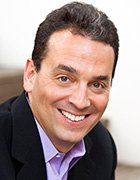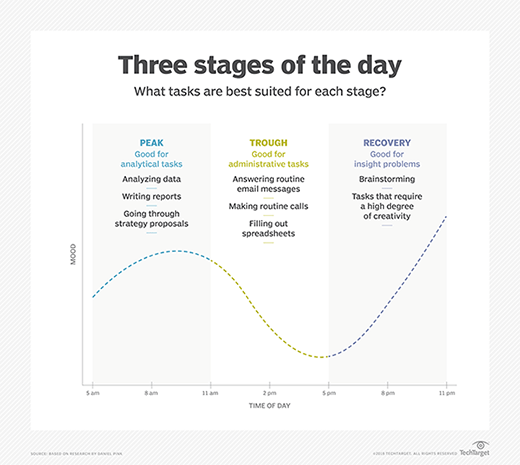Daniel Pink: How the science of timing can boost productivity
At the recent Gartner Data and Analytics Summit, best-selling author Daniel Pink urged digital leaders to follow the science of timing -- and spread the word.
We humans tend to think of timing as an art, shaped by some combination of intuition and guesswork. But timing is really a science, according to best-selling author and management and motivation guru Daniel Pink, who posits that when we do things is just as important as how we do them.
Pink, author of the forthcoming When: The Scientific Secrets of Perfect Timing, was a keynote speaker at the recent Gartner Data and Analytics Summit, where a big theme was how to exploit artificial intelligence technologies to improve enterprise data and analytics.
So, what does Pink have to say to a room full of data and analytics leaders who spend their time worrying about seemingly more pressing issues than the science of timing?
In a lively, TED-esque presentation, Pink spent an hour convincing an audience accustomed to making data-driven decisions that studying the data around timing can help us make better, smarter and shrewder decisions about when we do things.
Pink said he spent two years sifting through a mountain of research on the science of timing, spanning multiple academic disciplines to compile the evidence for his thesis about timing.
He broke his keynote presentation into three sections, focusing on how the rhythm of the day affects us, the importance of breaks and the revitalization that comes with endings.
Pay attention to a day's 'hidden pattern'
Point No. 1: Our mood and our performance are profoundly affected by what Pink referred to as the "hidden pattern of the day." He said his research showed the following:
- Our cognitive abilities don't remain static over the course of the day. They change in reasonably predictable ways.
- These daily fluctuations are more extreme than we realize. According to Russell Foster, professor of circadian neuroscience at the University of Oxford, "The performance change between the daily high point and the daily low point can be equivalent to the effect on performance of drinking the legal limit of alcohol."
- The best time to perform a task depends on the nature of that task.
 Daniel Pink
Daniel Pink
Among the examples Pink cited as evidence: Students taking standardized tests in Denmark perform worse in the afternoon than in the morning, regardless of school standing. Afternoon earnings calls were found to be more negative, irritable and combative than morning calls, even leading to temporary stock mispricings. Doctors performing colonoscopies find half as many polyps in afternoon exams than in morning exams. The list goes on, Pink said.
According to his research, most of us (80%) move through the day in three stages: a peak, a trough and a recovery. The 20% of people who are night owls tend to go in the reverse order: recovery, trough and peak. What should we do with this information? Pink detailed each stage of the day and suggested what kind of work is best suited for each stage:
Morning peak. This is when we should be doing our analytical tasks -- work that requires heads-down focus and vigilance. During this peak time, your mental state can bat away distractions, allowing you to think clearly. Pink said this is probably a good time to analyze data, to write a report and to go through systematic, hardcore strategy proposals.
Afternoon trough. Early to midafternoon -- "That's not good for very much," Pink joked. During this period, he suggested you do administrative work, answer routine emails and fill out your TPS reports. Or, take a siesta?
Late-day recovery. Moods are on the rise during this period, but we're less vigilant than we were during peak. What tasks are suited to a time when your mood is good, but your guard is down? This is the perfect period for what social psychologists call insight problems, or problems that are more creative and more conceptual, Pink said. For example, brainstorming: You don't want or need a high degree of vigilance during brainstorming sessions, but you do want a high degree of creativity.

Give me a break
Another thing that shows modern management's crude understanding of the science of timing? We underestimate the power of breaks, Pink said. He cited a somewhat alarming study of parole judges in Israel that found people were more likely to get parole in the morning and immediately after each break the judges took throughout the course of a day.
"I think the science of breaks is where the science of sleep was 15 years ago," Pink said. Fifteen to 20 years ago in the workplace, somebody who pulled multiple all-nighters and got little sleep was considered a hero and a productive member of the team; now, they're considered "an idiot," Pink said. That's because the data generated by sleep research changed our opinions and behavior.
Here's what the research on the science of timing tells us about breaks, according to Pink:
- Something beats nothing: A one- to two-minute break is better than no break at all.
- Moving beats stationary: You're better off moving around during a break than you are just sitting there.
- Social beats solo: Breaks are more restorative when they're taken with somebody else. This holds true even for introverts, which Pink found surprising.
- Outside beats inside: There are restorative and replenishing effects to simply seeing nature and being outside.
- Fully detached beats semi-attached: You're better off not talking about work during your breaks -- you perform at a higher level if you completely detach.
One takeaway, according to Pink, is not to think of breaks as a deviation from work -- think of them as a part of work. "We have this puritanical notion that we can't take a break because that's a sign of weakness, [and] that powering through ... is how you get stuff done, and powering through is morally virtuous. That's nonsense. Science is telling us different," Pink said.
Another piece of advice from Pink? Make a "break list." Schedule breaks the way you schedule meetings or anything else important. He recommended starting by scheduling two 10-minute breaks every day. "You should feel the difference," Pink asserted.
Takeaways from the science of timing:
- Be much more deliberate and intentional in scheduling individual and team work. "At an organizational level, it's a strategic decision; it's not a logistical decision."
- Move analytics tasks to the peak, administrative tasks to the trough and insight tasks to the recovery -- in your own schedule and in your team's schedule, where you can.
- Always give the bad news first.
- Shine a light on endings to energize yourself and others. "This is one reason why interim deadlines can be so important," Pink said.
- Use endings as "meaning makers." "When people get to the end of almost anything, it seems to trigger at least some kind of search for meaning."
The power of uplifting endings
"We live our lives in episodes," Pink said. "By their very nature, they have beginnings, midpoints and endings. Each of these things -- beginnings, midpoints and endings -- have different effects on our behavior."
People are most likely to run their first marathon at age 29, Pink said. Even more telling, 29-year-olds are twice as likely to run a first marathon as 28-year-olds are, and they're twice as likely to run a first marathon as 30-year-olds. Why? Because they're reaching the end of something -- in this case, a decade -- and, as Pink argued, endings light a fire under us.
"When we see the end of something, we kick a little harder," he said.
Another thing about endings: The vast majority of people prefer to begin with a loss or negative outcome and ultimately end with a gain or positive outcome, rather than the reverse.
"Given a choice, humans prefer endings that elevate. We prefer rising sequences to declining sequences," Pink said. "When people remember experiences, they disproportionately weigh what happens at the end. And if it's a rising sequence at the end, they remember it very well."
It's something to think about when you're interacting with clients or when you're organizing a team project, he said.
Pink had some final thoughts -- good and bad -- for his audience of data and analytics leaders:
"The bad news is that when it comes to issues of timing, we're still operating based on intuition and guesswork, and that is a big mistake," he said. Still, he said he believes evidence and data will prevail, but it will take "a little bit of a push."
"The good news is that there are people out there -- people like you -- who respect science, who respect data, who want to do a little bit better," he said, ending on a very uplifting note, indeed: "What this world needs are some first-movers like you."
Note to self: Check back with attendees to see how well they remember his talk.







